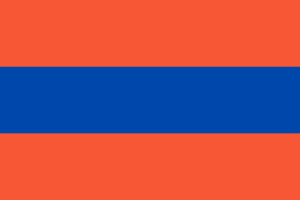Duchy of Nassau flag

History
Duchy of Nassau was apart of the German Confederation from 1806 – 1866 when it was annexed by Prussia. The duchy didn’t enter the German Confederation until 1815, before that it was in the Confederation of the Rhine. It was started by the (now extinct) House of Nassau, it had many thousands of years of historical making up to the 18th century, after that it was divided with 3 main lines, in what is now modern day Belgium, the provinces they became where Nassau-Usingen, Nassau-Weilburg and Nassau-Dietz (later Orange-Nassau). It stayed way until the war of The First Coallition (1792-1797), Nassau-Dietz lost its possesions in Belgium and Netherlands, while Nassau-Unsingen and Nassau-Weilburg lost all their terratories west of the Rhine river to France. But, like other German states, it gained land of the church because of secularisation, Nassau also participated in the negotiations of Second congress of Rastatt (1797) to secure territories of Prince-Bishop of Maniz and Trirer. The Imperial Recess (1803) largely accorded with the desires of Nassau-Usingen and Nassau-Weilburg. Orange-Nassau made diffrent terms with Napoleon. You can find more information in the Wiki page of Nassau-Usingen and Nassau-Weilburg losses and gains after The Imperial Recess and Second congress of Rastatt.
July 17. 1806. was the day when Nassau-Usingen and Nassau-Weilburg and their 2 princes, Frederick Augustus and Frederick William joined the confederation of the Rhine. Because Frederick Augustus was a senior member of the House of Nassau, he got the title of Sovereing Duke of Nassau, while Frederick William got the tittle of Sovereing Prince of Nassau. Napoleon I pressured them to make the Duchy of Nassau on the 30. of August 1806., this happend because Frederick Augustus had no male heirs, so Frederick William would be the ruler of Nassau anyway. There was more terratory added, because the blood-line of Orange-Nassau recived the Dutch crown on 31. of May 1815., it had to surrender their terratory (for some resson) to Prussia, but the day later Duchy of Nassau got it.
Tragically Fredederick William died on 9. of January 1806. by… falling down the stairs at Shloss Weilburg…what a way to go. He had a son named Frederick Wilhelm who was the first soul ruler after the death of Frederick Augustus on 24. of March 1806.
There was a reform period of the first years of the Duchy. First, serfdom (a type of slavery) was abolished in 1806, the introduction of the movement called ‘freedom of movement’ in 1810, a tax reform which replaced the former 991 taxes on land and trade to a single and progressive tax. The Kulturverordnung (cultivation ordinance) promoted atutonomous managment of the soil and land. After the transitonal period, the Duchy was devided into four provinces Weilburg, Wiesbaden and Ehrenbreistein, these we’re abolished in favour of Wiesbaden being the soul capital. The number of Amt subdivisions was reduced from 62 in 1806 to 48 in 1812.
Due to religious diffrences, the system of combined schools was introduced on the 24. of March 18167, on 14. of March 1818 public health system was introduced, a first one in Germany. Wow, if a small Duchy can do it, why the USA cant?
The parilament of Nassau was formed because of the constitution of 1814. There were 2 chambers in the parilament, the Chamber of Deputies and the House of Lords. The House of Lords had 11 members which were all princes of the House of Nassau or the representatives of the nobility, the 22 members of the Chamber of Deputies were mostly elected by the census suffrage except the three representatives of ecclesiastics and one representatives of the teachers. After just 4 years, there was an election for some resson the parlament didn’t play a role in this. Instead, 38 nobles, 1448 land owners 128 wealthy city dwellers were electorates, considering the population of the Duchy was 287.000 people, that was a tiny number electors. The paralament first met on the 3. of March 1818.
I will not include the Nassau dispute because i want to talk about the revolution and looks like its a dispute about mineral water and taxes so its boring. If you want to read it its below the Constotutions of 1814 on the official Wiki page.
Like most of Europe, Nassau was engulfed in a revolutionary wave after the February Revolution in France in 1848. On 1 March a liberal group headed by the jurist August Hergenhahn gathered at the Vier Jahreszeiten Hotel in Wiesbaden to present a list of moderate liberal nationalist demands to the government. This list included civil freedoms, a German national assembly, and a new electoral law. The next day, the Neun Forderungen der Nassauer (Nine Demands of the Nassauers) were presented to Chief Minister Emil Agustus von Dugern, who immediately approved the formation of a citizens’ militia, freedom of the press, and the convocation of the lower chamber of Parliament to discuss electoral reform. Decisions on the other demands were reserved for the Duke, who was in Berlin at that moment. In accordance with a proclamation of Hergenhahn, around 40,000 men assembled in Wiesbaden on 4 March. There was a clear conflict in this action, which would shape the subsequent development of events: while the circle around Hergenhahn hoped to receive confirmation of their demands by the acclamation of the people, they were mainly peasants, armed with scythes, cudgels, and axes, seeking the abolition of old Feudal impositions and an easing of forest and hunting laws. As the crowd moved restlessly through the city, the Duke announced from the balcony of his residence that he would meet all their demands. Then the crowd happily dispersed
I’m a gummy bear
bad